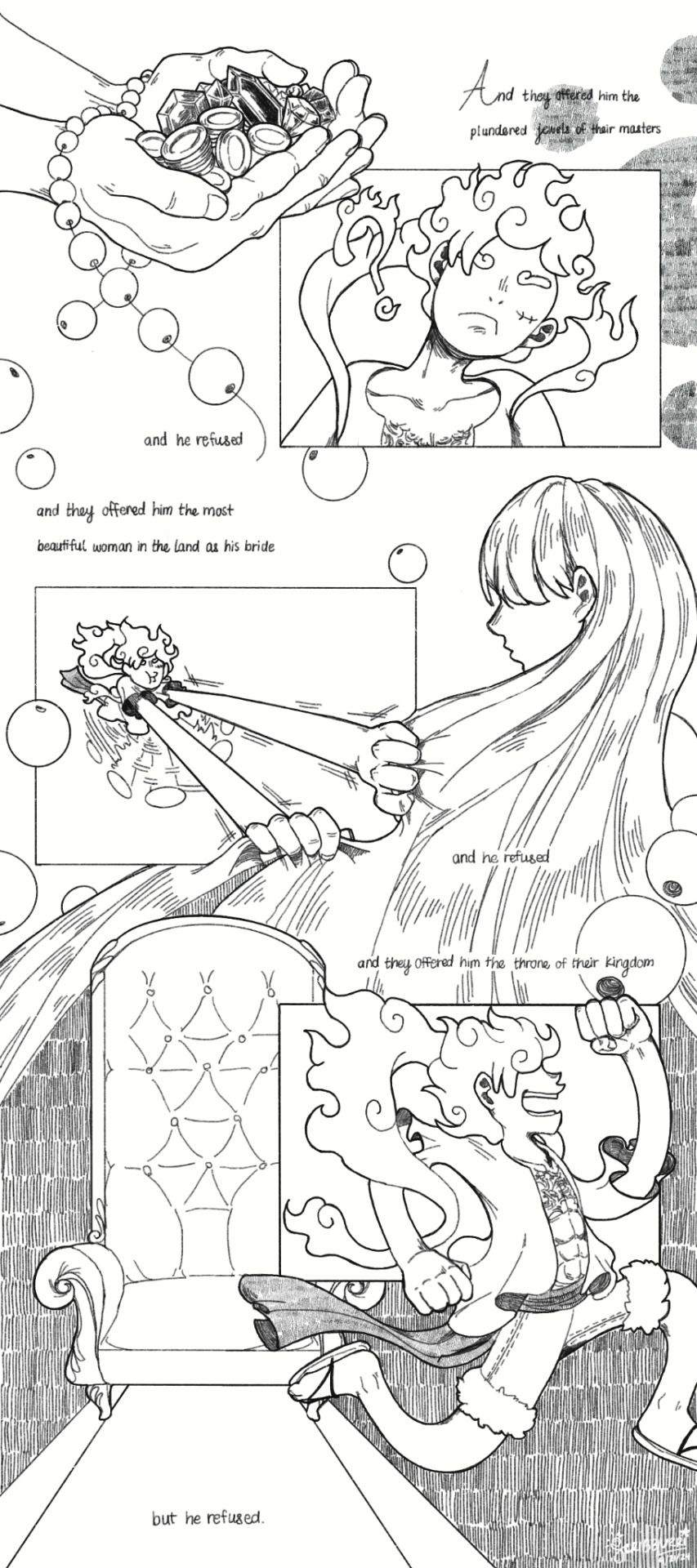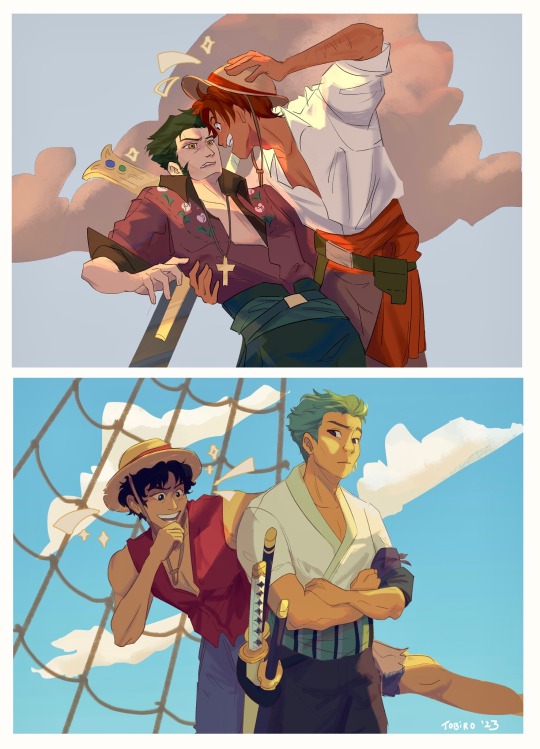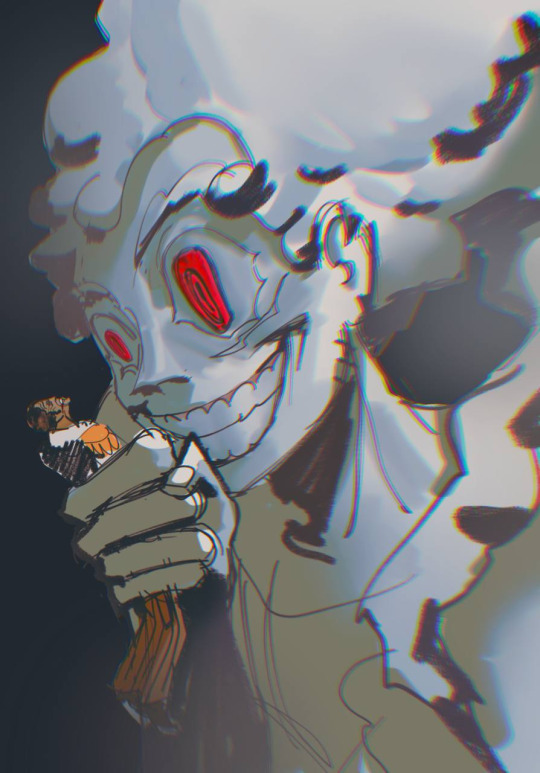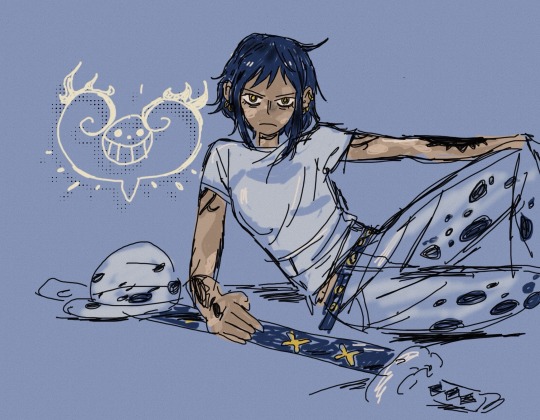Text
in the path of the sun
Trafalgar D Water Law experiences an escalating series of nuisances. Meanwhile, Monkey D Luffy learns some new tricks, gets dropped in the ocean, and awakens to a slapstick horizon of possibility. These things are related.
(The battle between the surgeon emperor of deathless Flevance and his latest challenger does not proceed as expected.)
part three of the upside-down roleswap series co-created by me, @grainjew, and @hopeworth!
#mom says its MY turn to post roleswap fic HEHEHE#please read this i think its good . its seven thousand words also#one piece#opfic
8 notes
·
View notes
Text
i just found out tumblr was storing over three GIGABYTES of cookies on my device without me knowing and that's why it's been running so fucking slow recently... incredible. anyways everyone go clear your fucking cookies. don't let this website run a goddamn video game's worth of disc space in the background for no good reason.
27K notes
·
View notes
Text


we pray to a new dawn
#YESSSS OHHH BLURRI THIS IS SO PERFECT#just staring at it . will continue to stare at it#the way you maintain the sense of one fairy tale being told with all these combined abstract images#the pearls falling down the page the doom doot dah dah in the music staff#the DYNAMISM of the whole thing#him launching himself out of the panel#this is so good . yea#gear 5#one piece#art for my fic#art#rb
87 notes
·
View notes
Text
inside an open grave
law & doflamingo & rosinante | teen and up audiences | roleswap au | 16.3k words
Trafalgar D Water Law loses his home, joins a pirate crew, gains two sons, reclaims his home, becomes an Emperor, sells drugs, loses two sons, and is thoroughly miserable the entire time. Naturally, this goes well for exactly nobody.
(The life and crimes of "Surgeon of Death" Trafalgar D Water Law, Emperor of the Sea.)
this is part 2 to the emperorswap au that @oriigami @grainjew and i have been working on where we roleswap kidd and law with kaidou and linlin. check out the other work in the series and bookmark or subscribe for future installments :)
#WAHOO#yea u should subscribe to this series#theres already two very fun fics in it of very divergent tones and theres gonna be MORE#rb#one piece#fic rec
30 notes
·
View notes
Text
outside the auction house
Rising Supernova captains Charlotte Linlin, Kaidou the Beast, and Monkey D Luffy meet for the first time at a Sabaody auction house and, inevitably, get along like a house on fire. Chaos ensues.
(You know how this story goes.)
(part 1 of a roleswap au i've been working on with @oriigami and @hopeworth ! follow the series to hear about their parts too <3 )
#points GO READ EMPERORSWAP it’s such a fun au#and there is gonna be more of it#rb#one piece#fic rec
10 notes
·
View notes
Text

live laugh luffy
2K notes
·
View notes
Text

1920s Baroque Works 🥂
Always wanted to do a movie poster redraw of the Great Gatsby so here they are!!
17K notes
·
View notes
Text
lets all pretend this is the first time im uploading this and tumblr didnt completely break the previous post, okay? okay.
#this fucks so hard i need to bite something#op IM!! IM!! im gonna watch this twenty million times#its scratching something in my brain#auauauhfhd#rb#one piece#video
238 notes
·
View notes
Text
Nikaposting Pt 2: Symbology & Syncretism
This is the second of a series of posts about Nika & associated religious practice in the One Piece world. As I write and post the rest of the series, I’ll add links to this header.
Pt 1: Crypto-Religion | Pt 3: Joyboy was Shandian
Enormous credit to @oriigami for being my discussion partner through all of this and having a substantial influence on the final product. Check out our ao3 series Joyful for a narrative rather than analytical take on the Nika tradition, and definitely go read her OP blog @kaizokuou-ni-naru for meta and translation fun facts.
-
So About That Sun Symbol (and all those sun gods)
Context note: This post assumes you’ve read pt 1. If you haven’t, the TLDR is that the Nika cult is best categorized as a crypto-religion and may not ever have existed outside of a cryptic and oral form.
There’s a lot of sun gods in One Piece. And there’s a lot of appearances of that sun symbol we discussed briefly in pt 1, with the disconnected rays. This post will cover that symbol, the survival of non-Kuma Nika cult branches, and the proliferation of sun gods across the One Piece world.
The sun symbol can be found everywhere, in what seems at first to be a wildly disparate collection of places. There are a number of borderline cases, so I’ll be defining the “Nika sun symbol” as being any symbol with a central circle, disconnected rays, and four- or eight-fold radial symmetry. This leaves us the below list (images of the majority of these instances can be found in this very helpful post):
The Kuma-Bonney/Buccaneer version found in his church and on the amulet he left for her (8 circular rays) ; this is our basic template for the symbol
The Alabasta national symbol (8 droplet-shaped rays; the droplets seem to be drawn at various different orientations depending on the panel)
The Kozuki crest (8 circular rays in the center of a bird in the center of another circle also there’s some sprouts or something)
The Shandian crest (8 circular rays inside a larger circle, also the central circle contains the kanji for kami/god)
The Sun Pirates’ mark (4 more traditional flaring rays; the rays seem to be drawn inconsistently, especially in the anime)
There’s also Ace’s dagger, which has the basic template version, but one can assume he bought that thing in Alabasta or something like that.
From this we can conclude that the sun with disconnected rays is not exclusively a Nika symbol- in fact I would be surprised if it was, because of how prominently it was displayed in Kuma’s church (see the discussion in pt 1). However, Alabasta, Shandora, and Wano are all poneglyph countries, and were all involved in some way or another in [incomprehensible void century muttering]. I would be extremely unsurprised if the sun with disconnected rays wasn’t a more widely-spread popular symbol among [void century muttering] countries back then, which was adopted by Nika worshippers as their secret symbol around that time and simultaneously retained in more benign form by certain nations as an element of their national symbology.
(Sidenote: If you were unaware, Oda snagged this symbol from a castle in his hometown and clearly just seems to enjoy drawing it. However that doesn’t matter to us in meta analysis land. We continue.)
The Nika cult absolutely survived outside Kuma’s family: at the very least, among slaves on Mariejois. There’s a very high chance Fisher Tiger heard Nika stories while enslaved- the compositional similarity of the Sun Pirates’ mark to the base Nika symbol, Jinbe’s pissed off refusal to answer any of Who’s-Who’s questions, Fisher Tiger’s own status as a warrior of liberation, and of course, the Sun Pirates’ name and the importance of the sun to the residents of Fishman Island all point in this direction.
The proliferation of the Nika sun symbol across the world also points, to me, to at least pockets of the Nika cult potentially surviving in cryptic form across the world, like Kuma’s family did, with various levels of conscious awareness about what their rituals and symbols actually mean and what secret seditious knowledge they’re actually carrying.
However! All that said! Not all sun gods are Nikas- At least, not completely.
Upon their arrival at Egghead Island, Dorry and Broggy identified Luffy as the Sun God. However, I contend that Nika was not originally Elbaf’s sun god.
In expository Nika dialogue, Nika is specifically cited as a god of slaves (& as an ethnic or cultural god of the buccaneer people), and the giants as far as we know are (1), not a traditionally enslaved people nor particularly easy to enslave, (2), are based on Vikings & have their own pantheon which includes a god of war, & (3), while I can absolutely see how a tradition of a prolonged fast > feast festival would have evolved around a Nika figure, it does still feel a little strange. That’s supposed to be a Luffy-alike!
Besides this, the Shandian pantheon also includes a sun god, and I think it’s reasonable to assume that the sun god in question existed prior to any awakened user of the Nika fruit running around causing issues (although, more on my thoughts about Joyboy and Shandora in pt 3). Human sacrifice traditions also feel about as odd for a Luffy figure as fasting does, and while obviously Luffy, Joyboy, and Nika aren’t the same person, with the way One Piece’s narrative conventions work they’re probably quite similar.
Solar deities are the lynchpins of many if not most traditions in the real world. Sun’s a very notable noticable thing that follows a set course across the sky and brings light and life! And especially in One Piece, where the sun is also a critical thematic element and motif, I would be surprised if the majority of One Piece cultures hadn’t developed their own sun gods at some point or other.
So, all that said, why were Dorry and Broggy calling Luffy Sun God? Syncretism.
Not every god has a mythical zoan or the things would be wildly more common- only gods and figures with, as @oriigami put it while we were talking about this, a particularly potent wish attached to them. Even fewer gods have awakened mythical zoan users around. So when an awakened user of a sun god’s mythical zoan is running around (and particularly, a sun god with an incredibly potent wish attached, because Nika is a god of liberation as well as the sun, and it’s a god that people wish they could be and emulate as a matter of course), it’s easy to fold them into your mythology as your sun god. Tradition is very malleable! He’s the sun, even if he’s not exactly how you traditionally pictured it.
Traditions are very good at working with what they get, and at the moment what they get is a smiling, laughing pirate captain and liberator of slaves. What could be better?
57 notes
·
View notes
Text
Nikaposting Pt 1: Crypto-Religion
This is the first of a series of posts about Nika & associated religious practice in the One Piece world. As I write and post the rest of the series, I’ll add links to this header.
Pt 2: Syncretism & Symbology | Pt 3: Joyboy was Shandian
Enormous credit to @oriigami for being my discussion partner through all of this and having a substantial influence on the final product. Check out our ao3 series Joyful for a narrative rather than analytical take on the Nika tradition, and definitely go read her OP blog @kaizokuou-ni-naru for meta and translation fun facts.
-
The Nika Cult is a Crypto-Religion
Terminology note: I will be using cult in these posts in the sense of “cult of worship,” rather than in the modern pejorative sense. Additionally, I tend to use “tradition” rather than “religion” as a general term, because “religion” is a messy and difficult to define concept, while “tradition” is much more inclusive of traditional practices, folk beliefs, and cults of worship that may not be considered religions by Western scholarship.
Raise your hand if you saw Kuma’s church and Bible, concluded “oh, the Nika stuff is basically One Piece Christianity,” and moved on with your life.
It’s an easy assumption to make, and for all I know authorial intent may well stop there. I’m not Oda. I’ll never be able to guess what goes on behind those fish eyes of his. But a second look at the worldbuilding around both Nika and Christianity in One Piece brought me to a very different conclusion: that the Nika cult is a crypto-religion and is, in Kuma’s case, using the outward appearance of Christianity as camouflage.
First of all: We have ample evidence that Christianity (or some variation of it- I’m fascinated by the implied existence of such things as One Piece Jerusalem and the One Piece Council of Nicea) does exist in the One Piece world, and is both fairly widespread and quite legal. Flevance was pretty explicitly Catholic (Law went to church as a kid), Miss Monday and Mother Carmel masqueraded as nuns to imply harmlessness, many if not most of the graves shown in the series are crosses, whatever Usopp was on about with that exorcism equipment, and, yes, Kuma’s church and Bible.
Even mentioning the Nika cult, on the other hand, is grounds for the government to assassinate you with extreme prejudice.
A crypto-religion is what happens when a religion is suppressed to the point that its practice is grounds for exile, torture, and/or execution: Some people will convert. Some people will flee into exile. Some people will die. And some people will outwardly adopt the dominant religion, but will continue to practice their own traditions in secret; ie, they’ll create a crypto-religion.
One of the more famous examples of this is the post-Spanish Inquisition crypto-Jews of Spain and Portugal, who converted to Christianity in public but kept what Jewish traditions and rituals they could in private. To this day, descendants of these conversos whose families have been Catholic for centuries are discovering that their family tradition of lighting two candles on Friday or not eating pork on Saturday are in fact the legacy of a violently suppressed heritage. There are countless other examples of crypto-religions throughout history, both among Jews (my own personal field of knowledge) and among other traditions (for an example that would be known to Oda, the crypto-Christians of Japan).
There’s no way the Nika cult could have survived except in cryptic form. If it ever had physical infrastructure in the form of temples or pilgrimage sites, the government would have sought them out and demolished them long ago if they were not adequately disguised, especially in World Government member states like the Sorbet Kingdom. Likewise, anyone foolish enough to speak publicly about Nika will be summarily assassinated.
In fact, I have doubts that the Nika cult ever existed outside cryptic form, at least in a significant or long-lasting manner. It was specifically introduced as a slave tradition, likely nigh-exclusively oral, practiced in secret either from its inception—if Nika was a figure created by slaves, including the buccaneers—or for a very long time—if it was the cultural or ethnic tradition of the buccaneers, which spread from enslaved buccaneers to non-buccaneer slaves because Nika was a figure that resonated with them. I tend the favor the second option, but either has merit.
As @oriigami said when we were talking about this, Kuma has a church. Kuma has a bible. Kuma worships a god about whom absolutely nothing is written except in the oldest texts.
Additionally, I’ll expand on this more in pt 2 of this series, but the pendant Kuma leaves for Bonney, a large circular sapphire surrounded by eight smaller circular sapphires, matches the circular symbol inset into the crosses of his church. Bonney immediately identifies the pendant as a sun even though it really doesn’t look like one, and it can be surmised therefore that it’s a Nika amulet, and the sun with disconnected rays a Nika symbol. Following this read, and especially because this symbol occurs across the world in other contexts (see pt 2 for my thoughts on that), its presence in the church is a very careful bit of architectural sleight of hand on the part of whichever of Kuma’s ancestors built the place- echoing a very common practice of real-world crypto-religion adherents to mark the true nature of their allegiances and houses of worship in ways only those in the know might recognize.
And on a storytelling level, Kuma’s entire presence in the narrative and in the world has been a tragic saga of appearing to be one way until he’s revealed, again and again, to be the opposite. It makes thematic sense for him to be fooling the world about his faith as well!
88 notes
·
View notes
Text

the history book on the shelf is always repeating itself
24K notes
·
View notes
Text

#NGNFNFMGMFF RB FHGFDJMFMF#yeah this rules . hi . hi . hi#wow he’s gonna eat that admiral#rb#art#one piece
2K notes
·
View notes
Text
Love Trans Women Forever.
34K notes
·
View notes
Text
CUNO: Yeah well Cuno hopes you get run over by a motor carriage covered in hammers, pig! What do you say about that?
CUNOESSE: You tell 'em Cuno! Tell those pigs you hope it explodes too!
AUTHORITY (TRIVIAL: FAILED): A serious threat has just been made against your life. Respond accordingly.
10K notes
·
View notes




